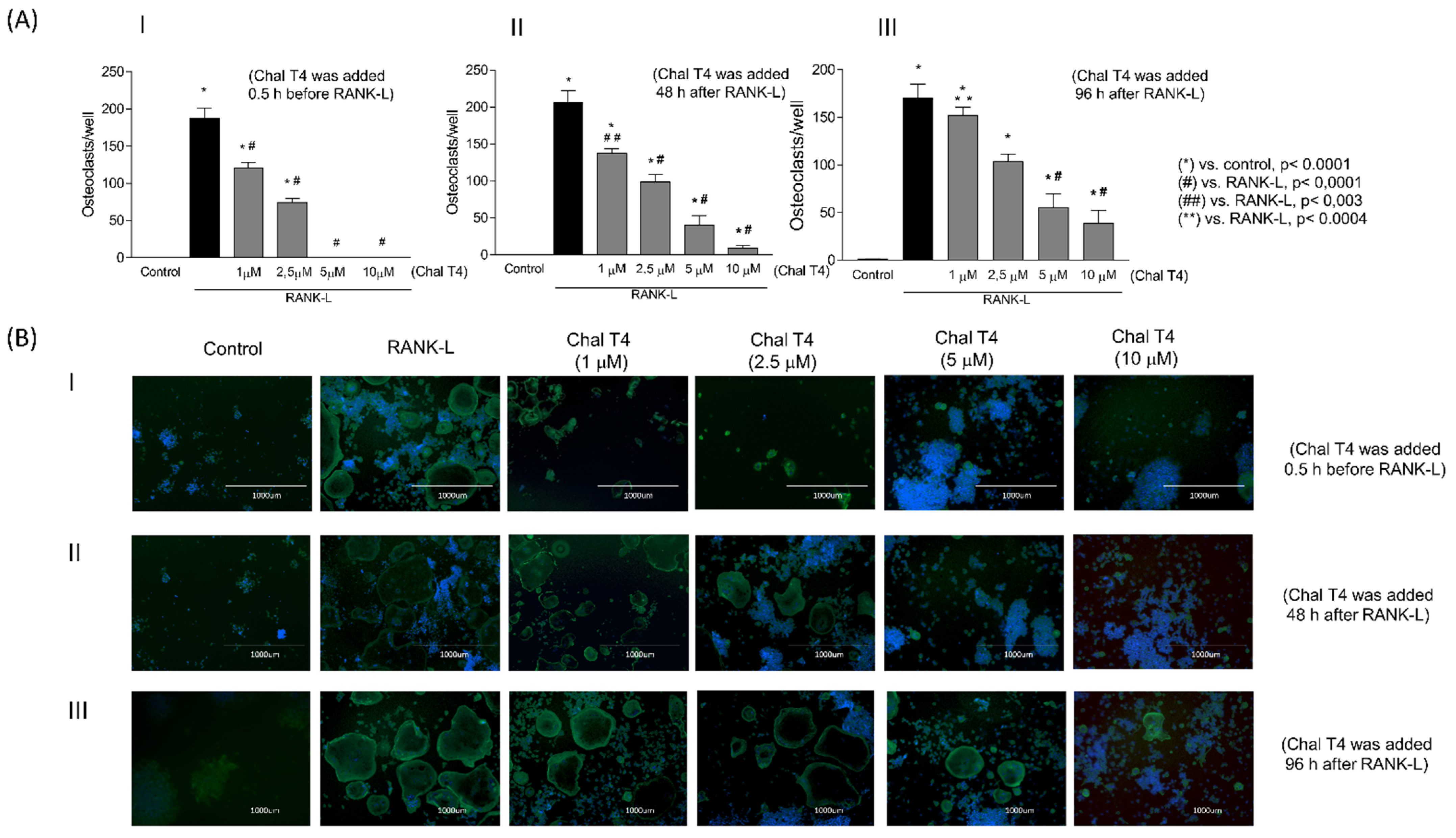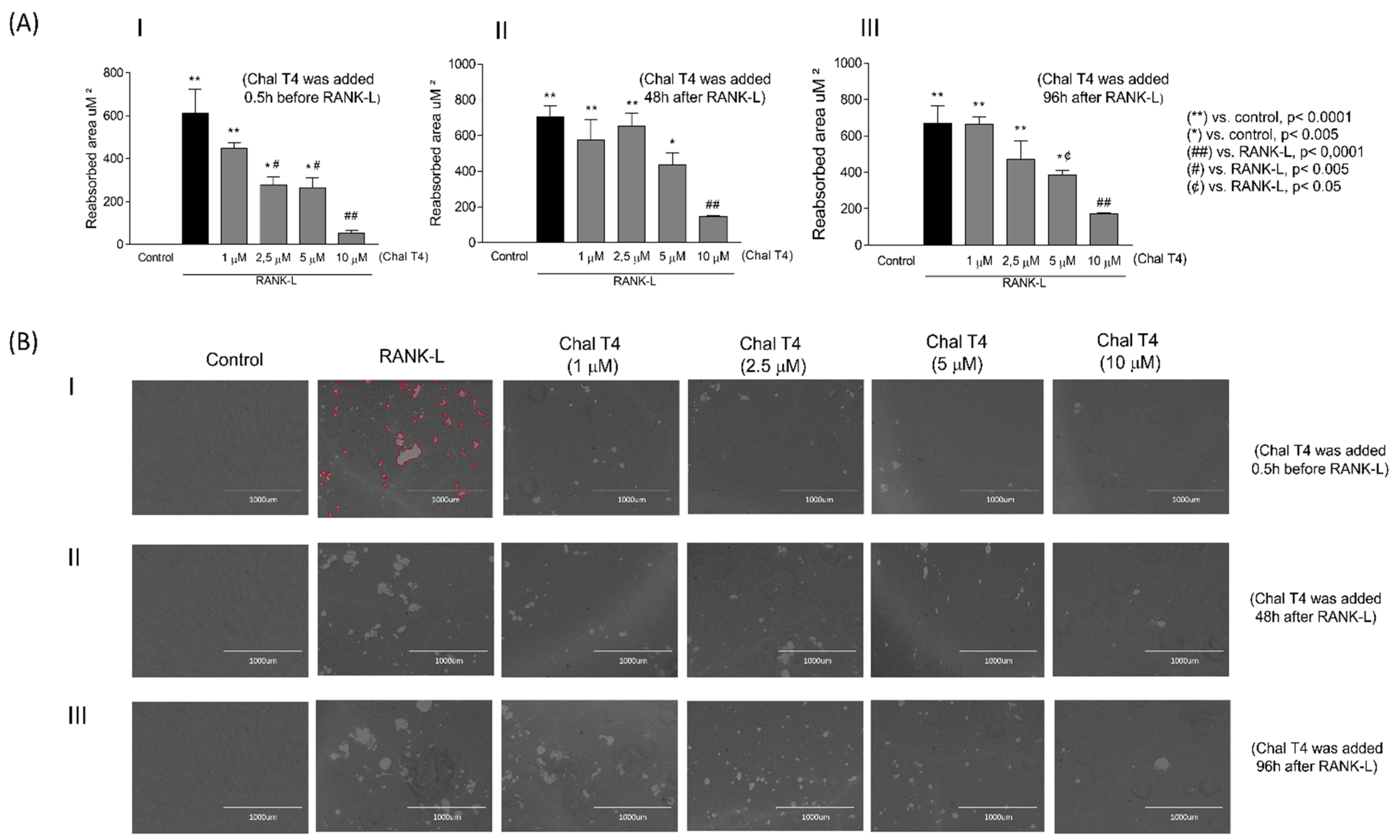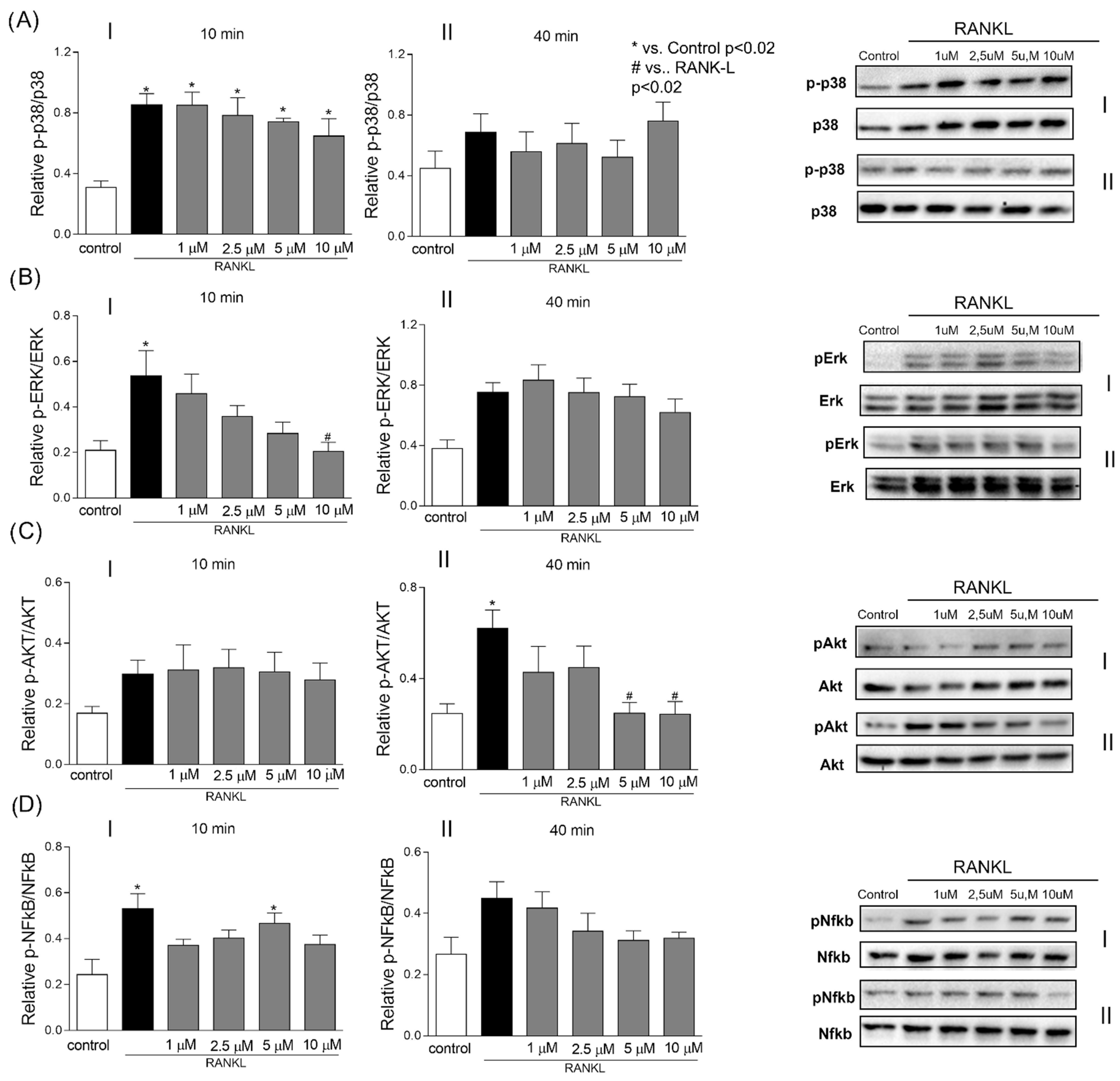Chalcone T4 Inhibits RANKL-Induced Osteoclastogenesis and Stimulates Osteogenesis In Vitro
Abstract
1. Introduction
2. Results
2.1. Chalcone T4 Inhibits Osteoclast Differentiation and Activity in a Dose-Dependent Manner
2.2. Chalcone T4 Reduces Expression of Osteoclastogenesis Markers, and Inhibits RANKL-Induced Activation of ERK and AKT
2.3. Chalcone T4 Stimulates Formation of Mineralized Matrix and Expression of Osteogenic Markers
3. Discussion
4. Materials and Methods
4.1. Chalcone T4
4.2. Effect of Chalcone T4 on Osteoclast Differentiation
4.3. Effect of Chalcone T4 on Osteoclast Activity
4.4. Evaluation of Cytokine Gene Expression (RT-qPCR)
4.5. Role of Chalcone in the Activation of Intracellular Signaling Pathways (Western Blot)
4.6. Effect of Chalcone T4 on Osteogenic Differentiation (Alizarin Red and RT-qPCR)
4.7. Statistical Analysis
Supplementary Materials
Author Contributions
Funding
Institutional Review Board Statement
Informed Consent Statement
Data Availability Statement
Conflicts of Interest
References
- Eriksen, E.F. Cellular mechanisms of bone remodeling. Rev. Endocr. Metab. Disord. 2010, 11, 219–227. [Google Scholar] [CrossRef]
- Kobayashi, N.; Kadono, Y.; Naito, A.; Matsumoto, K.; Yamamoto, T.; Tanaka, S.; Inoue, J.I. Segregation of TRAF6-mediated signaling pathways clarifies its role in osteoclastogenesis. EMBO J. 2001, 20, 1271–1280. [Google Scholar] [CrossRef]
- Boyle, W.J.; Simonet, W.S.; Lacey, D.L. Osteoclast differentiation and activation. Nature 2003, 15, 337–342. [Google Scholar] [CrossRef] [PubMed]
- Verron, E.; Bouler, J.M. Is bisphosphonate therapy compromised by the emergence of adverse bone disorders? Drug Discov. Today 2014, 19, 312–319. [Google Scholar] [CrossRef] [PubMed]
- Çetinkaya, M.B.; Kökçü, A.; Yanik, F.F.; Başoğlu, T.; Malatyalioglu, E.; Alper, T. Comparison of the effects of transdermal estrogen, oral estrogen, and oral estrogenprogestogen therapy on bone mineral density in postmenopausal women. J. Bone Miner. Metab. 2002, 20, 44–48. [Google Scholar]
- Golub, L.M.; Lee, H.-M. Periodontal therapeutics: Current host-modulation agents and future directions. Periodontology 2000 2020, 82, 186–204. [Google Scholar] [CrossRef]
- Fernandes, N.A.R.; Camilli, A.C.; Maldonado, L.A.G.; Pacheco, C.G.P.; Silva, A.F.; Molon, R.S.; Spolidorio, L.C.; Ribeiro de Assis, L.; Regasini, L.Q.; Rossa Junior, C.; et al. Chalcone T4, a novel chalconic compound, inhibits inflammatory bone resorption in vivo and suppresses osteoclastogenesis in vitro. J. Periodontal Res. 2021, 56, 569–578. [Google Scholar] [CrossRef]
- Rudrapal, M.; Khan, J.; Dukhyil, A.A.B.; Alarousy, R.M.I.I.; Attah, E.I.; Sharma, T.; Khairnar, S.J.; Bendale, A.R.; Barraja, P.; Montalbano, A.; et al. Chalcone Scaffolds, Bioprecursors of Flavonoids: Chemistry, Bioactivities, and Pharmacokinetics. Molecules 2021, 26, 7177. [Google Scholar] [CrossRef] [PubMed]
- Hsieh, H.-K.; Tsao, L.-T.; Wang, J.-P.; Lin, C.-N. Synthesis and Anti-inflammatory Effect of Chalcones. J. Pharm. Pharmacol. 2000, 52, 163–171. [Google Scholar] [CrossRef] [PubMed]
- Batovska, D.I.; Todorova, I.T. Trends in Utilization of the Pharmacological Potential of Chalcones. Curr. Clin. Pharmacol. 2010, 5, 1–29. [Google Scholar] [CrossRef]
- Takeshita, S.; Kaji, K.; Kudo, A. Identification and Characterization of the New Osteoclast Progenitor with Macrophage Phenotypes Being Able to Differentiate into Mature Osteoclasts. J. Bone Miner. Res. 2000, 15, 1477–1488. [Google Scholar] [CrossRef]
- Chen, X.; Cai, X.; Le, R.; Zhang, M.; Gu, X.; Shen, F.; Hong, G.; Chen, Z. Isoliquiritigenin protects against sepsis-induced lung and liver injury by reducing inflammatory responses. Biochem. Biophys. Res. Commun. 2018, 496, 245–252. [Google Scholar] [CrossRef] [PubMed]
- Nakamura, S.; Watanabe, T.; Tanigawa, T.; Shimada, S.; Nadatani, Y.; Miyazaki, T.; Iimuro, M.; Fujiwara, Y. Isoliquiritigenin Ameliorates Indomethacin-Induced Small Intestinal Damage by Inhibiting NOD-Like Receptor Family, Pyrin Domain-Containing 3 Inflammasome Activation. Pharmacology 2018, 101, 236–245. [Google Scholar] [CrossRef]
- Ali, A.A.; Al Haleem, E.N.A.; Khaleel, S.A.-H.; Sallam, A.S. Protective effect of cardamonin against acetic acid-induced ulcerative colitis in rats. Pharmacol. Rep. 2017, 69, 268–275. [Google Scholar] [CrossRef] [PubMed]
- Jung, E.-G.; Han, K.-I.; Kwon, H.-J.; Patnaik, B.B.; Kim, W.-J.; Hur, G.M.; Nam, K.-W.; Han, M.-D. Anti-inflammatory activity of sappanchalcone isolated from Caesalpinia sappan L. in a collagen-induced arthritis mouse model. Arch. Pharmacal Res. 2015, 38, 973–983. [Google Scholar] [CrossRef]
- Zheng, W.; Zhang, H.; Jin, Y.; Wang, Q.; Chen, L.; Feng, Z.; Chen, H.; Wu, Y. Butein inhibits IL-1β-induced inflammatory response in human osteoarthritis chondrocytes and slows the progression of osteoarthritis in mice. Int. Immunopharmacol. 2017, 42, 1–10. [Google Scholar] [CrossRef]
- Maurya, S.W.; Dev, K.; Singh, K.B.; Rai, R.; Siddiqui, I.R.; Singh, D.; Maurya, R. Synthesis and biological evaluation of heterocyclic analogues of pregnenolone as novel anti-osteoporotic agents. Bioorg. Med. Chem. Lett. 2017, 27, 1390–1396. [Google Scholar] [CrossRef] [PubMed]
- Almelah, E.; Smith, D.P.T.; McGown, A.; Aziz, A.; Potgieter, H.J.; Ragazzon, P. Dibenzoyl-methane Derivatives as a Potential and Exciting New Therapy for the Treatment of Childhood Bone Cancer. Anticancer. Res. 2016, 36, 6043–6050. [Google Scholar] [CrossRef]
- Mansky, K.C.; Sankar, U.; Han, J.; Ostrowski, M.C. Microphthalmia Transcription Factor Is a Target of the p38 MAPK Pathway in Response to Receptor Activator of NF-κB Ligand Signaling. J. Biol. Chem. 2002, 277, 11077–11083. [Google Scholar] [CrossRef]
- Van de Laar, L.; van den Bosch, A.; Boonstra, A.; Binda, R.S.; Buitenhuis, M.; Janssen, H.L.A.; Coffer, P.J.; Woltman, A.M. PI3K-PKB hyperactivation augments human plasmacytoid dendritic cell development and function. Blood J. Am. Soc. Hematol. 2012, 120, 4982–4991. [Google Scholar] [CrossRef]
- He, Y.; Staser, K.; Rhodes, S.D.; Liu, Y.; Wu, X.; Park, S.J.; Yuan, J.; Yang, X.; Li, X.; Jiang, L.; et al. Erk1 positively regulates osteoclast differentiation and bone resorptive activity. PLoS ONE 2011, 6, e24780. [Google Scholar] [CrossRef] [PubMed]
- Gingery, A.; Bradley, E.; Shaw, A.; Oursler, M.J. Phosphatidylinositol 3-Kinase Coordinately Activates the MEK/ERK and AKT/NFkB Pathways to Maintain Osteoclast Survival. J. Cell. Biochem. 2003, 89, 165–179. [Google Scholar] [CrossRef] [PubMed]
- Yang, F.-C.; Chen, S.; Robling, A.G.; Yu, X.; Nebesio, T.D.; Yan, J.; Morgan, T.; Li, X.; Yuan, J.; Hock, J.; et al. Hyperactivation of p21ras and PI3K cooperate to alter murine and human neurofibromatosis type 1–haploinsufficient osteoclast functions. J. Clin. Investig. 2006, 116, 2880–2891. [Google Scholar] [CrossRef] [PubMed]
- Jimi, E.; Takakura, N.; Hiura, F.; Nakamura, I.; Hirata-Tsuchiya, S. The Role of NF-κB in Physiological Bone Development and Inflammatory Bone Diseases: Is NF-κB Inhibition “Killing Two Birds with One Stone”? Cells 2019, 8, 1636. [Google Scholar] [CrossRef] [PubMed]
- Kim, H.; Kim, M.-B.; Kim, C.; Hwang, J.-K. Inhibitory Effects of Panduratin A on Periodontitis-Induced Inflammation and Osteoclastogenesis through Inhibition of MAPK Pathways In Vitro. J. Microbiol. Biotechnol. 2018, 28, 190–198. [Google Scholar] [CrossRef] [PubMed]
- Suh, K.S.; Rhee, S.Y.; Kim, Y.S.; Lee, Y.S.; Choi, E.M. Xanthohumol Modulates the Expression of Osteoclast-Specific Genes during Osteoclastogenesis in RAW264.7 Cells. Food Chem. Toxicol. 2013, 62, 99–106. [Google Scholar] [CrossRef] [PubMed]
- Jeong, S.; Lee, S.; Lim, S. Isoliquiritigenin Derivatives Inhibit RANKL-Induced Osteoclastogenesis by Regulating p38 and NF-_B Activation in RAW264.7 Cells. Molecules 2020, 25, 3908. [Google Scholar] [CrossRef]
- Kim, S.N.; Bae, S.J.; Kwak, H.B.; Min, Y.K.; Jung, S.H.; Kim, C.H.; Kim, S.H. In Vitro and in Vivo Osteogenic Activity of Licochalcone A. Amino Acids 2012, 42, 1455–1465. [Google Scholar] [CrossRef]
- Leitão, E.P.T. Chalcones: Retrospective Synthetic Approaches and Mechanistic Aspects of a Privileged Scaffold. Curr. Pharm. Des. 2020, 26, 2843–2858. [Google Scholar] [CrossRef]
- Komori, T. Runx2, an inducer of osteoblast and chondrocyte differentiation. Histochem. Cell Biol. 2018, 149, 313–323. [Google Scholar] [CrossRef]
- Abdallah, B.M.; Ali, E.M. Butein Promotes Lineage Commitment of Bone Marrow-Derived Stem Cells into Osteoblasts via Modulating ERK1/2 Signaling Pathways. Molecules 2020, 25, 1885. [Google Scholar] [CrossRef] [PubMed]
- Tempone, A.G.; Theodoro, R.D.S.; Romanelli, M.M.; Santos Ferreira, D.A.; Amaral, M.; Ribeiro de Assis, L.; Santa Cruz, L.M.; Costa, A.R.; Zanella, R.C.; Christodoulides, M.; et al. A new reduced chalcone-derivative affects the membrane permeability and electric potential of multidrug-resistant Enterococcusfaecalis. Chem. Biol. Interact. 2022, 365, 110086. [Google Scholar] [CrossRef] [PubMed]
- Livak, K.J.; Schmittgen, T.D. Analysis of relative gene expression data using real-time quantitative PCR and the 2(-Delta Delta C(T)) Method. Methods 2001, 25, 402–408. [Google Scholar] [CrossRef] [PubMed]





Disclaimer/Publisher’s Note: The statements, opinions and data contained in all publications are solely those of the individual author(s) and contributor(s) and not of MDPI and/or the editor(s). MDPI and/or the editor(s) disclaim responsibility for any injury to people or property resulting from any ideas, methods, instructions or products referred to in the content. |
© 2023 by the authors. Licensee MDPI, Basel, Switzerland. This article is an open access article distributed under the terms and conditions of the Creative Commons Attribution (CC BY) license (https://creativecommons.org/licenses/by/4.0/).
Share and Cite
de Matos, I.A.F.; Fernandes, N.A.R.; Cirelli, G.; de Godoi, M.A.; de Assis, L.R.; Regasini, L.O.; Rossa Junior, C.; Guimarães-Stabili, M.R. Chalcone T4 Inhibits RANKL-Induced Osteoclastogenesis and Stimulates Osteogenesis In Vitro. Int. J. Mol. Sci. 2023, 24, 7624. https://doi.org/10.3390/ijms24087624
de Matos IAF, Fernandes NAR, Cirelli G, de Godoi MA, de Assis LR, Regasini LO, Rossa Junior C, Guimarães-Stabili MR. Chalcone T4 Inhibits RANKL-Induced Osteoclastogenesis and Stimulates Osteogenesis In Vitro. International Journal of Molecular Sciences. 2023; 24(8):7624. https://doi.org/10.3390/ijms24087624
Chicago/Turabian Stylede Matos, Iolanda Augusta Fernandes, Natalie Aparecida Rodrigues Fernandes, Giovani Cirelli, Mariely Araújo de Godoi, Letícia Ribeiro de Assis, Luis Octávio Regasini, Carlos Rossa Junior, and Morgana Rodrigues Guimarães-Stabili. 2023. "Chalcone T4 Inhibits RANKL-Induced Osteoclastogenesis and Stimulates Osteogenesis In Vitro" International Journal of Molecular Sciences 24, no. 8: 7624. https://doi.org/10.3390/ijms24087624
APA Stylede Matos, I. A. F., Fernandes, N. A. R., Cirelli, G., de Godoi, M. A., de Assis, L. R., Regasini, L. O., Rossa Junior, C., & Guimarães-Stabili, M. R. (2023). Chalcone T4 Inhibits RANKL-Induced Osteoclastogenesis and Stimulates Osteogenesis In Vitro. International Journal of Molecular Sciences, 24(8), 7624. https://doi.org/10.3390/ijms24087624







